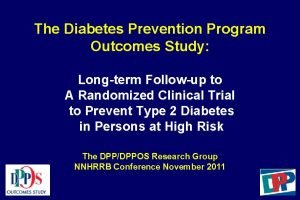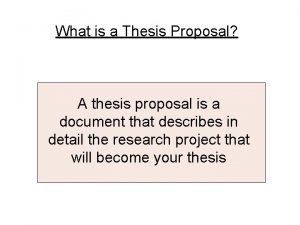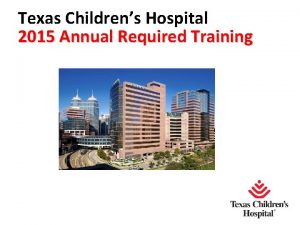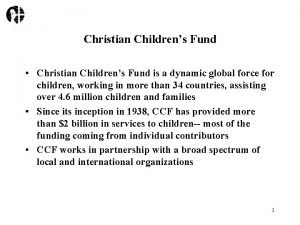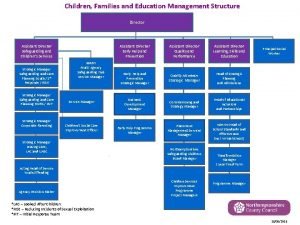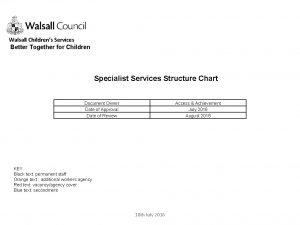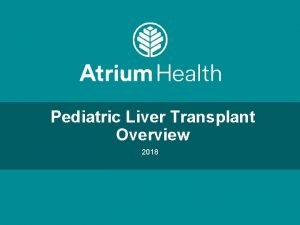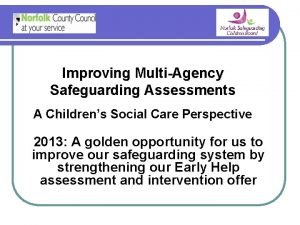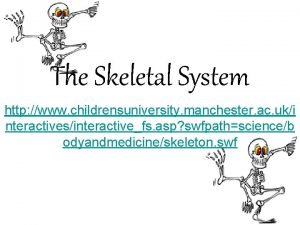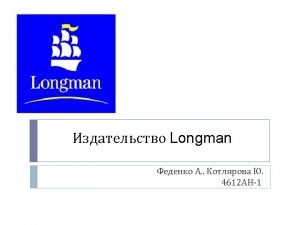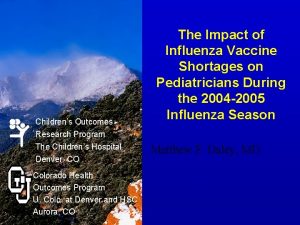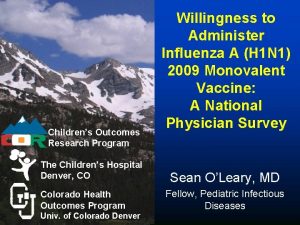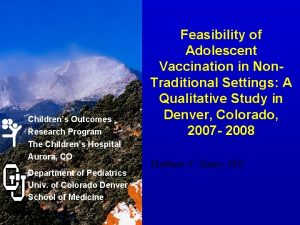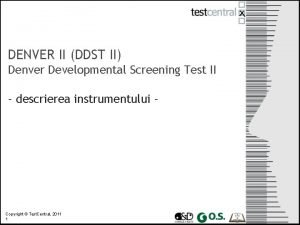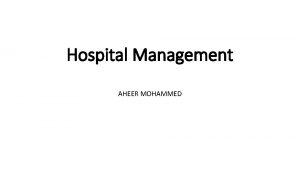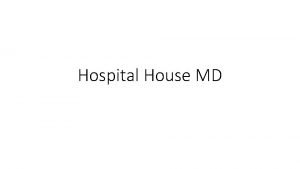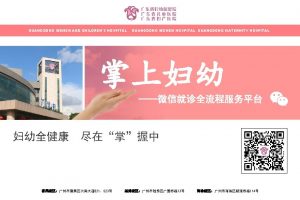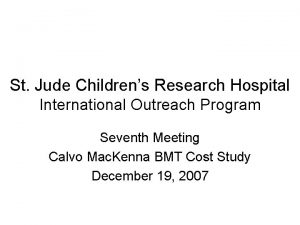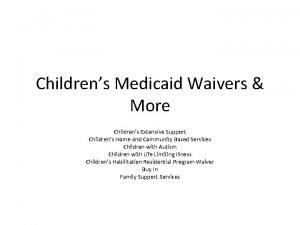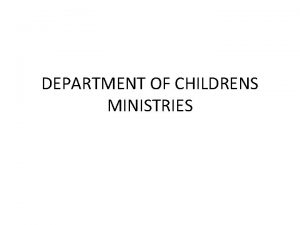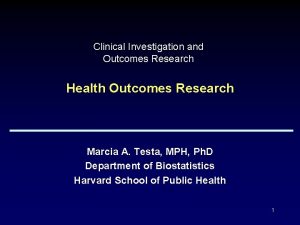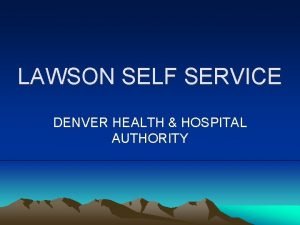Childrens Outcomes Research Program The Childrens Hospital Denver



























- Slides: 27

Children’s Outcomes Research Program The Children’s Hospital Denver, CO Colorado Health Outcomes Program University of Colorado HSC Denver, CO A Qualitative Study of Physicians’ Experiences Ordering and Receiving Influenza Vaccine During the 2005 -2006 Influenza Season Jennifer L Pyrzanowski, BA Lori A Crane, Ph. D, MPH Jennifer Barrow, MSPH Christine Babbel, MSPH Allison Kempe, MD, MPH Matthew F Daley, MD

Background § Influenza vaccine delivery involves: • Manufacturing • Distribution • Administration

Background § Physicians play a critical role in the administration of influenza vaccine • Physician recommendation associated with increased likelihood of vaccination • Vaccinations occur primarily in medical offices § In five of the last six influenza seasons there have been vaccine manufacturing and/or distribution problems § Little published research on the impact vaccine supply problems have had on physicians’ practices

Study Objectives To qualitatively explore, during the 20052006 influenza season… § the experiences general internists and pediatricians had ordering and receiving influenza vaccine § the impact of shortages and delays on physicians’ practices

Study Population § Sentinel Provider Networks • Developed for the Vaccine Policy Collaborative Initiative • Providers recruited from random samples of professional organizations (AAP and ACP) to participate in 2 -4 surveys per year • Selected to be representative of the AAP and the ACP with respect to § § § Region of the country (NE, S, MW, W) Location (urban, suburban, rural) Setting (private, HMO, community/hospital based)

Survey Design and Administration § Administered in Nov 2005 § Prompted by anecdotal reports from physicians related to vaccine supply issues § Over 3 weeks, sent physicians up to 4 email links to web-based survey

Survey Design and Administration § 5 closed ended questions pertaining to: Orders placed % of orders received Suppliers Patient referrals § An open-ended, free-text item about problems physicians encountered ordering and receiving influenza vaccine “Please feel free to comment further on any problems you may have encountered with ordering and receiving influenza vaccine this year. ”

Analysis § Content analysis using standard qualitative methods • Coded responses and grouped by theme • Two independent reviewers § Findings for pediatricians and general internists assessed together and separately

Results § Free text responses received from 155 physicians § § 53/156 (34%) general internists 102/180 (57%) pediatricians

Characteristics of respondents to free-text survey item Region Midwest Northeast South West Location Urban Suburban Rural Practice Setting Private HMO Hosp/Clinic Median Age Peds GIM 14% 33% 30% 23% 15% 30% 25% 12% 73% 16% 9% 70% 21% 88% 1% 11% 51 92% 0% 6% 49

Findings of content analysis § Overall, pediatricians’ and general internists’ responses did not differ with respect to issues raised § Responses categorized into four general themes: 1) Barriers to obtaining influenza vaccine 2) The impact shortages/delays had on practices 3) Additional issues encountered regarding influenza vaccine 4) Overall perceptions of influenza vaccine delivery in the U. S.

Barriers to obtaining influenza vaccine § Reported ordering problems • Perceptions of the small window of opportunity to place orders • A practice’s initial order being denied • Failed attempts to place additional orders • Limits to how much vaccine a practice could order

Barriers to obtaining influenza vaccine (con’t) § Reported ordering problems • Limits to how much vaccine a practice could order “I don’t understand why we can’t order a large number from the manufacturer if we are first time customers; what difference should that make? ” (GIM) “I was limited to what I ordered last year, though my practice has increased in size especially asthmatics and babies” (Peds)

Barriers to obtaining influenza vaccine (con’t) § Reported vaccine arrival issues • • Orders not arriving Late arrival of orders Staggered arrival of orders Shipments received insufficient for practice’s needs

Barriers to obtaining influenza vaccine (con’t) § Reported vaccine arrival issues • Staggered arrival of orders “…only shipping small amounts at the time with long intervals between that are unknown to us. ” (GIM) “…received order in multiple shipments. ” (Peds)

The effect of shortages / delays on practices § Concern with inability to vaccinate patients § Perception of negatively impacted patientphysician relationship § Reports of increased workload to obtain and manage available vaccine supply

The effect of shortages / delays on practices (con’t) § Reports of increased workload to obtain and manage available vaccine supply “I have been able to get vaccine but it has been a labor intensive process. ” (GIM) “We are just about managing to immunize the risk pts-but it is a daily grind to check supplies. ” (Peds)

The effect of shortages / delays on practices (con’t) § Perception of negatively impacted patientphysician relationship “Our reputation was compromised as our patients faithfully waited for our flu clinic which we could not put on. ” (GIM) “Many BLAME us for not having the vaccine they want. ” (Peds)

Additional issues encountered regarding influenza vaccine § Perceptions regarding the availability of the vaccine at non-medical facilities § Reports of cost-related concerns § Perceived poor communication from distributors/manufacturers/government

Additional issues encountered regarding influenza vaccine (con’t) § Perceived poor communication “I am struck by the utter lack of communication. We cannot get any answer from the supplier as to why vaccine is not available to us…[or] from responsible gov’t agencies. ” (GIM) “Once again, families and physicians were confused by the different levels of vaccine availability for priority and non-priority patients. ” (Peds)

Additional issues encountered regarding influenza vaccine (con’t) § The perceived availability of the vaccine at non-medical facilities “…I have been extremely dissatisfied with the distribution of influenza vaccine. It seems that major retail stores have the vaccine and offer it to the ‘walking healthy’ but I cannot offer it to sick, debilitated patients I see in my office…” (GIM) “It is very frustrating that corporations, who are mostly immunizing healthy workers so easily get vaccine when small practices have a hard time…” (Peds)

Overall perceptions of influenza vaccine delivery in the U. S. § Recommendations, explanations and other general perceptions “Federal government should control production, distribution, and access. ” (GIM) “The priority system [for the distribution of influenza vaccine] should be private physicians first, hospitals, health dept’s, then private companies. ” (Peds)

Strengths and Limitations (+) § Large sample for qualitative study § National in scope § Surveyed during the peak season (Oct/Nov) when vaccination occurs (-) § Findings limited to those who responded to the open-ended survey item § Open-ended questions often elicit strongly held opinions

Summary of Findings § Physicians perceive a number of problems with the influenza vaccine distribution/supply system § Physicians’ concerns are primarily related to their ability to vaccinate their patients § Overall issues raised do not vary greatly between general internists and pediatricians

Summary of Findings § Notable perceptions: • Poor communication from manufacturers/distributors/government • Increased workload to obtain and manage vaccine supply • Concern about prioritized distribution to non-medical facilities • Doctor-patient relationship negatively impacted

Conclusions § Further quantitative research is needed to clarify these problems and quantify the scope of problems § Issues raised by this study not well explored in the literature • Means of communication between distributors / manufacturers / gov’t agencies & physicians’ practices • Impact of shortages/delays on practice workload • Impact of vaccine availability at nonmedical facilities on physician practices

Acknowledgments § This investigation was funded by the Centers for Disease Control and Prevention, through the Rocky Mountain Prevention Research Center, Denver, CO
 Program specific outcomes nba
Program specific outcomes nba Diabetes prevention program outcomes study
Diabetes prevention program outcomes study Expected results research proposal example
Expected results research proposal example Expected results research proposal example
Expected results research proposal example Functions of hospital pharmacist
Functions of hospital pharmacist Texaschildrens moli
Texaschildrens moli The christian childrens fund
The christian childrens fund Childrens services
Childrens services Walsall childrens services
Walsall childrens services Levine childrens
Levine childrens 23 april international children's day turkey
23 april international children's day turkey Multi agency assessment
Multi agency assessment World literature quiz 22
World literature quiz 22 Skeletal system
Skeletal system Longman children's dictionary
Longman children's dictionary Black childrens memorial
Black childrens memorial Fever in toddler
Fever in toddler History of childrens literature
History of childrens literature Colorado childrens book award
Colorado childrens book award Hát kết hợp bộ gõ cơ thể
Hát kết hợp bộ gõ cơ thể Lp html
Lp html Bổ thể
Bổ thể Tỉ lệ cơ thể trẻ em
Tỉ lệ cơ thể trẻ em Chó sói
Chó sói Tư thế worms-breton
Tư thế worms-breton Chúa yêu trần thế alleluia
Chúa yêu trần thế alleluia Các môn thể thao bắt đầu bằng từ đua
Các môn thể thao bắt đầu bằng từ đua Thế nào là hệ số cao nhất
Thế nào là hệ số cao nhất

